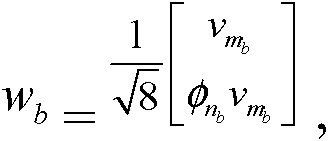Cooperative precoding method, cooperative information interaction method and system
A technology for precoding information and interactive methods, applied in the field of cooperative precoding methods, can solve problems such as scheduling constraints, channel information quantization errors, channel estimation errors, etc., and achieve the effects of eliminating interference, high scheduling flexibility, and small SINR.
- Summary
- Abstract
- Description
- Claims
- Application Information
AI Technical Summary
Problems solved by technology
Method used
Image
Examples
Embodiment 1
[0063] Assuming that there are cell A and cell B, the two cells may or may not belong to the same base station, and perform coordinated transmission. Both cell A and cell B have Nt transmit antennas. On a time-frequency transmission resource M, M is one RB (ResourceBlock, resource block) or multiple RBs, cell A uses w for its serving user UE1 a For precoding, when Nt=8, that is, when there are 8 transmitting antennas, w a It may be a codeword in the 8-antenna layer 1 codebook in the LTE-A standard.
[0064] The codebook model of LTE-A standard 8-antenna 1-layer is:
[0065] W m , n ( 1 ) = 1 8 v m φ n v ...
Embodiment 2
[0071] There are cell A and cell B, which belong to or do not belong to the same base station, and perform cooperative transmission. Cells A and B both have Nt transmit antennas.
[0072] On a time-frequency transmission resource M, M is one RB (ResourceBlock, resource block) or multiple RBs, cell A uses w for its serving user UE1 a For precoding, when Nt=4, w a It may be a codeword in the 4-antenna layer 1 codebook in the LTE / LTE-A standard as shown in Table 1.
[0073] Table 1: List of 4-antenna codebooks
[0074]
[0075] in, I is the unit matrix, Represents the matrix W k The jth column of the vector. Represents the matrix W k the jth 1 , j 2 ,..., j n A matrix of columns. for example can be
[0076]On the same time-frequency transmission resource M, cell B uses w b for precoding, w b It may be a codeword in the 4-antenna layer 1 codebook in the LTE-A standard.
[0077] for example can be Or the other in the 4-antenna codebook with w a Orthogonal ...
Embodiment 3
[0079] There are cell A and cell B, which belong to the same base station or to different base stations, and perform coordinated transmission. Cells A and B both have Nt transmit antennas.
[0080] On a time-frequency transmission resource M, where M is one RB (ResourceBlock) or multiple RBs, cell A uses w for its serving user UE1 a For precoding, when Nt=8, w a It may be two columns of a codeword in the 8-antenna layer 4 codebook in the LTE-A standard.
[0081] The codeword model in the LTE-A 8-antenna 4-layer time codebook is:
[0082]
[0083] where: φ n = e jπn / 2 , v m =[1e j2πm / 32 e j4πm / 32 e j6πm / 32 ] T ,
[0084] v m′ =[1e j2πm′ / 32 e j4πm′ / 32 e j6πm′ / 32 ] T
[0085] For example, it could be in,
[0086] It is a complex number, which can take the value of 1, -1, j, -j, etc., For DFT vectors:
[0087] v m a = 1 ...
PUM
 Login to View More
Login to View More Abstract
Description
Claims
Application Information
 Login to View More
Login to View More - R&D
- Intellectual Property
- Life Sciences
- Materials
- Tech Scout
- Unparalleled Data Quality
- Higher Quality Content
- 60% Fewer Hallucinations
Browse by: Latest US Patents, China's latest patents, Technical Efficacy Thesaurus, Application Domain, Technology Topic, Popular Technical Reports.
© 2025 PatSnap. All rights reserved.Legal|Privacy policy|Modern Slavery Act Transparency Statement|Sitemap|About US| Contact US: help@patsnap.com



